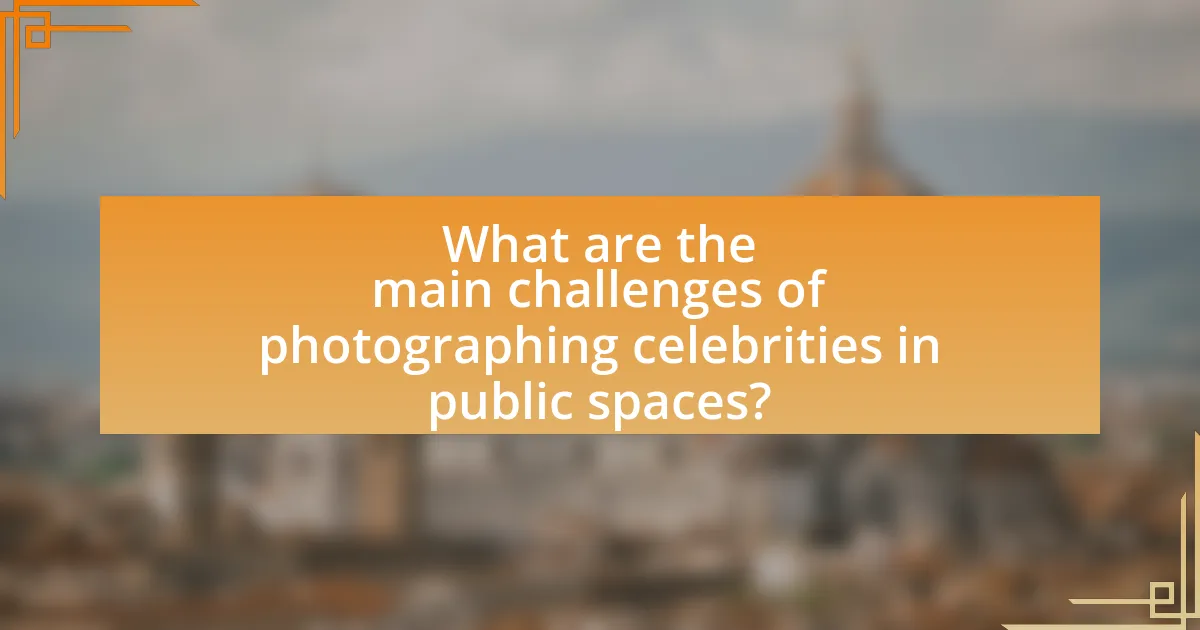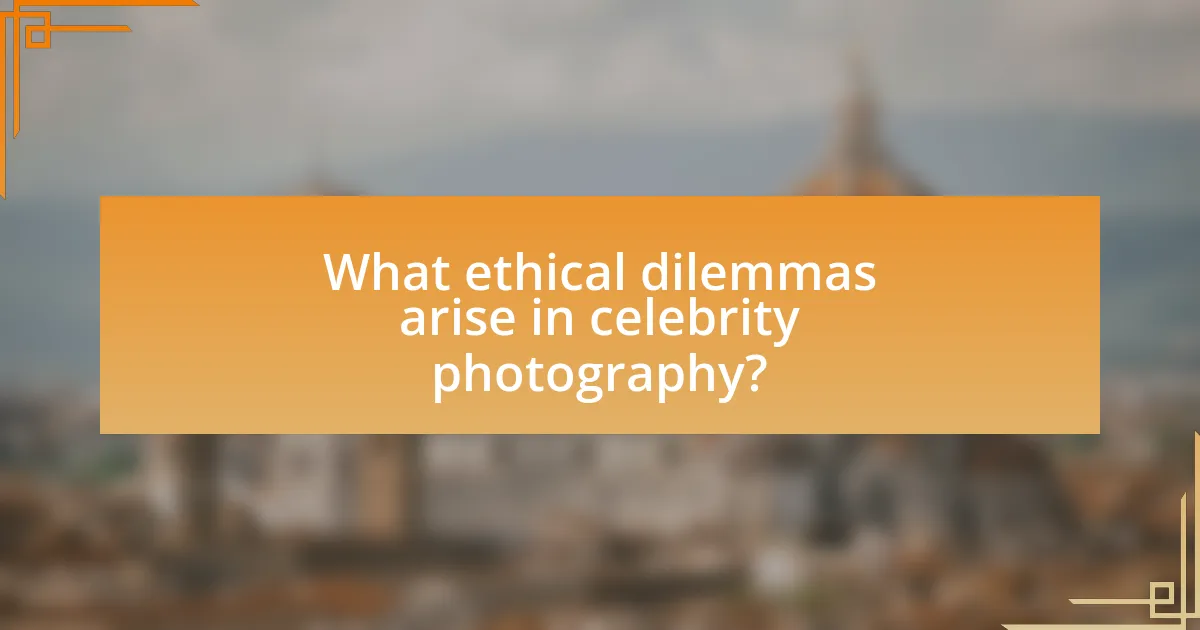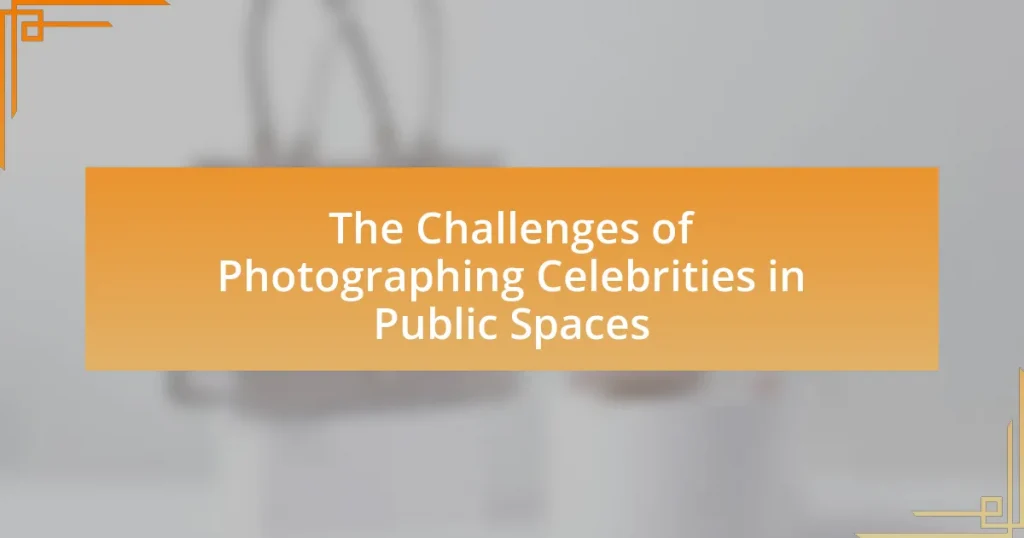The article examines the challenges of photographing celebrities in public spaces, highlighting key issues such as privacy concerns, unpredictable crowd behavior, and legal restrictions. It discusses how public visibility affects both the demand for candid images and the behavior of celebrities, as well as the impact of location on photography opportunities. Additionally, the article addresses ethical dilemmas, legal considerations, and strategies photographers can employ to navigate these challenges while maintaining professionalism and respect for their subjects. Techniques for improving the photography experience in crowded areas and the essential equipment needed for effective celebrity photography are also outlined.

What are the main challenges of photographing celebrities in public spaces?
The main challenges of photographing celebrities in public spaces include privacy concerns, unpredictable behavior of crowds, and legal restrictions. Privacy concerns arise as celebrities often seek to maintain a level of anonymity, leading to potential confrontations with photographers. Unpredictable crowd behavior can hinder the ability to capture clear images, as fans may rush towards the celebrity, creating chaotic situations. Legal restrictions, such as laws regarding trespassing and harassment, can limit where and how photographers can operate, impacting their ability to take photographs effectively. These factors collectively complicate the task of capturing candid and respectful images of public figures.
How does public visibility impact celebrity photography?
Public visibility significantly impacts celebrity photography by increasing the demand for candid images and influencing the behavior of both photographers and celebrities. When celebrities are in public spaces, their visibility attracts photographers who seek to capture spontaneous moments, often leading to a competitive environment where quick reflexes and strategic positioning are essential. This heightened visibility can also affect how celebrities present themselves, as they may alter their behavior or appearance knowing they are being photographed, which can lead to a more staged or curated image rather than a genuine candid shot. Additionally, studies indicate that the rise of social media has amplified this phenomenon, as platforms like Instagram encourage both celebrities and photographers to share more frequent and immediate content, further blurring the lines between private and public life.
What role does location play in the challenges faced by photographers?
Location significantly influences the challenges faced by photographers, particularly when capturing celebrities in public spaces. Urban environments often present obstacles such as crowds, unpredictable lighting, and varying levels of accessibility, which can hinder the photographer’s ability to get the desired shot. For instance, busy streets may limit the photographer’s movement and increase the likelihood of obstructions in the frame. Additionally, locations with strict regulations, such as private properties or events, can restrict access and create legal challenges for photographers. These factors collectively complicate the task of effectively capturing images of celebrities in dynamic public settings.
How do crowds affect the ability to capture clear images?
Crowds significantly hinder the ability to capture clear images due to obstruction and movement. When numerous people are present, they can block the photographer’s line of sight, leading to partially obscured subjects and distracting backgrounds. Additionally, the constant movement of individuals within a crowd can introduce motion blur, making it difficult to achieve sharp focus on the intended subject. Studies in photography have shown that environments with high density of people often result in lower image quality, as the likelihood of encountering obstructions and dynamic motion increases.
What legal considerations must photographers be aware of?
Photographers must be aware of copyright laws, privacy rights, and model release requirements when capturing images, especially of celebrities in public spaces. Copyright laws protect the photographer’s ownership of their work, while privacy rights dictate that individuals have a reasonable expectation of privacy, even in public settings. Additionally, obtaining model releases is crucial when using images for commercial purposes, as it grants permission from the subject to use their likeness. These legal considerations are essential to avoid potential lawsuits and ensure compliance with applicable laws.
How do privacy laws influence celebrity photography?
Privacy laws significantly influence celebrity photography by establishing legal boundaries that protect individuals’ rights to privacy in public and private spaces. These laws, such as California’s Civil Code Section 1708.8, restrict the use of images taken without consent in certain contexts, particularly when they invade personal privacy or are used for commercial purposes. As a result, photographers must navigate these regulations carefully to avoid legal repercussions, which can limit their ability to capture candid moments of celebrities in public settings. The enforcement of these laws has led to increased scrutiny and potential lawsuits against photographers who fail to comply, thereby shaping the practices and ethics surrounding celebrity photography.
What are the implications of copyright in celebrity images?
Copyright in celebrity images primarily protects the rights of photographers and the celebrities themselves, influencing how these images can be used commercially. Photographers hold copyright over their images, granting them control over reproduction, distribution, and public display, which can lead to legal disputes if unauthorized use occurs. For instance, the case of “Elder v. Burch” highlighted that unauthorized use of a celebrity’s image can result in significant financial penalties. Additionally, celebrities may assert their rights to control the commercial use of their likeness, as seen in laws like California’s Celebrities Rights Act, which allows them to protect their image from exploitation. Thus, copyright implications in celebrity images encompass both the protection of creative works and the management of personal rights, shaping the landscape of celebrity photography in public spaces.
How does the behavior of celebrities affect photography opportunities?
The behavior of celebrities significantly influences photography opportunities by either enhancing or limiting access for photographers. When celebrities engage positively with the public, such as posing for photos or interacting with fans, they create more opportunities for photographers to capture candid and appealing images. Conversely, if celebrities exhibit negative behavior, such as avoiding the public or reacting aggressively to photographers, it can lead to restricted access and fewer opportunities for capturing their images. For instance, high-profile incidents where celebrities have confronted paparazzi can result in tighter security measures and increased privacy, thereby reducing the likelihood of spontaneous photography.
What strategies do celebrities use to avoid being photographed?
Celebrities employ various strategies to avoid being photographed, including using disguises, employing bodyguards, and utilizing decoys. Disguises, such as hats, sunglasses, and different clothing styles, help them blend in with the crowd and make it harder for photographers to recognize them. Bodyguards often create a physical barrier between the celebrity and the paparazzi, controlling access and minimizing exposure. Additionally, some celebrities use decoys to mislead photographers, drawing attention away from their actual location. These methods are frequently reported in entertainment news, highlighting the lengths to which public figures go to maintain their privacy in public spaces.
How does a celebrity’s public persona influence their accessibility?
A celebrity’s public persona significantly influences their accessibility by shaping public perception and expectations regarding their availability. For instance, celebrities who cultivate a relatable and approachable image often find themselves more accessible to fans and the media, as their persona invites interaction. Conversely, those who project an exclusive or aloof image may limit their accessibility, leading to heightened barriers between them and the public. Research indicates that celebrities with a more down-to-earth public persona, such as Ellen DeGeneres, tend to engage more frequently with fans, resulting in increased opportunities for public encounters. This dynamic illustrates how a celebrity’s crafted image directly impacts their interactions and accessibility in public spaces.

What ethical dilemmas arise in celebrity photography?
Ethical dilemmas in celebrity photography primarily involve issues of privacy, consent, and the potential for exploitation. Photographers often capture images of celebrities in public spaces without their explicit consent, raising questions about the right to privacy versus the public’s interest in celebrity culture. For instance, the legal framework in many jurisdictions allows for photography in public spaces, but ethical considerations suggest that individuals, regardless of their fame, deserve a degree of privacy. Additionally, the aggressive tactics sometimes employed by paparazzi can lead to dangerous situations, as seen in incidents involving high-profile figures like Princess Diana, who tragically died in a car crash while being pursued by photographers. This highlights the moral responsibility of photographers to balance their professional pursuits with respect for the personal lives of the subjects they capture.
How do photographers balance public interest and personal privacy?
Photographers balance public interest and personal privacy by adhering to ethical guidelines and legal standards that govern photography in public spaces. They often prioritize the context of the photograph, ensuring that the images serve a legitimate public interest, such as news reporting or artistic expression, while being mindful of the subjects’ right to privacy. For instance, laws like the California Civil Code Section 1708.8 protect individuals from being photographed in situations where they have a reasonable expectation of privacy, such as in their homes or private events. This legal framework compels photographers to navigate the fine line between capturing public figures in their professional capacity and respecting their personal lives, ultimately fostering a responsible approach to photography that considers both societal interests and individual rights.
What are the ethical implications of invasive photography techniques?
Invasive photography techniques raise significant ethical implications, primarily concerning privacy violations and consent. These techniques often involve capturing images of individuals without their knowledge or permission, infringing on their right to privacy, which is a fundamental human right recognized in various legal frameworks, including the Universal Declaration of Human Rights. Furthermore, the psychological impact on subjects, particularly celebrities, can lead to distress and a sense of vulnerability, as evidenced by numerous reports of mental health issues stemming from relentless public scrutiny. The ethical debate also encompasses the responsibility of photographers and media outlets to balance the public’s interest in celebrity culture with respect for individual dignity and autonomy.
How can photographers respect boundaries while still capturing moments?
Photographers can respect boundaries while capturing moments by obtaining consent from subjects before taking their photographs. This practice not only honors individual privacy but also fosters a respectful relationship between the photographer and the subject. For instance, many professional photographers adhere to guidelines set by organizations such as the National Press Photographers Association, which emphasizes the importance of ethical photography, particularly in public spaces. By prioritizing consent and being mindful of personal space, photographers can effectively balance their artistic goals with the need to respect the rights and boundaries of individuals.
What responsibilities do photographers have towards their subjects?
Photographers have the responsibility to respect the privacy and dignity of their subjects. This includes obtaining consent before capturing images, especially in sensitive situations, and being mindful of how the images may affect the subjects’ reputation and personal life. For instance, ethical guidelines in photography emphasize the importance of treating subjects with respect and ensuring that their portrayal is fair and accurate. Additionally, photographers should be aware of the legal implications of photographing individuals in public spaces, as laws regarding privacy and image rights can vary significantly.
How can photographers ensure they are not exploiting celebrities?
Photographers can ensure they are not exploiting celebrities by obtaining informed consent before capturing images. This practice respects the autonomy and privacy of the individual, aligning with ethical standards in photography. For instance, the American Society of Media Photographers emphasizes the importance of consent, stating that photographers should seek permission, especially in sensitive situations. Additionally, adhering to legal guidelines regarding privacy rights, such as those outlined in the California Civil Code, can further protect against exploitation. By prioritizing consent and legal compliance, photographers can maintain ethical integrity while engaging with public figures.
What guidelines can photographers follow to maintain ethical standards?
Photographers can maintain ethical standards by respecting the privacy and consent of their subjects, particularly when photographing celebrities in public spaces. This involves obtaining permission when possible, being mindful of the context in which images are taken, and avoiding intrusive or deceptive practices. For instance, the National Press Photographers Association emphasizes the importance of ethical conduct, stating that photographers should not exploit individuals’ vulnerabilities or invade their personal space without consent. Additionally, adhering to local laws regarding photography in public spaces can further ensure ethical practices.
How does public perception influence the practice of celebrity photography?
Public perception significantly influences the practice of celebrity photography by shaping the demand for images and the ethical considerations surrounding them. When the public views celebrity images as desirable, photographers are motivated to capture more candid and intimate moments, often leading to invasive practices. For instance, the rise of social media has heightened the public’s appetite for real-time celebrity content, prompting photographers to adopt aggressive tactics to meet this demand. Additionally, negative public sentiment towards invasive photography can lead to backlash against photographers and media outlets, resulting in stricter regulations and self-imposed guidelines within the industry. This dynamic illustrates how public perception not only drives the market for celebrity photography but also dictates the ethical boundaries that photographers navigate.
What impact does social media have on the demand for celebrity images?
Social media significantly increases the demand for celebrity images by providing instant access to a vast audience. Platforms like Instagram and Twitter allow fans to engage with celebrities in real-time, creating a continuous appetite for fresh content. According to a study by the Pew Research Center, 72% of adults use social media, which amplifies the visibility of celebrity images and drives their consumption. This heightened demand is further evidenced by the rise in paparazzi activity and the proliferation of fan-generated content, indicating that social media not only fuels interest but also shapes the dynamics of celebrity culture.
How do public reactions shape the behavior of photographers?
Public reactions significantly influence the behavior of photographers by dictating their approach to capturing images, especially in sensitive contexts like photographing celebrities. When photographers encounter negative public reactions, such as hostility or disapproval, they may alter their tactics to avoid confrontation, opting for more discreet methods or even refraining from taking photos altogether. For instance, studies have shown that photographers often assess the crowd’s mood and adjust their presence accordingly; if a celebrity is met with enthusiasm, photographers may feel encouraged to capture more candid moments, while a hostile environment may lead them to retreat. This dynamic illustrates how public sentiment can directly impact the strategies and decisions photographers make in real-time, ultimately shaping the nature of the images they produce.

What techniques can improve the experience of photographing celebrities in public spaces?
To improve the experience of photographing celebrities in public spaces, photographers should utilize techniques such as maintaining a respectful distance, using long lenses, and being aware of the environment. Maintaining a respectful distance helps to avoid intrusiveness, which can lead to negative interactions with the celebrity. Using long lenses allows photographers to capture high-quality images without being too close, preserving the subject’s comfort and privacy. Additionally, being aware of the environment, including lighting and background elements, can enhance the composition and overall quality of the photographs. These techniques are supported by industry practices that emphasize ethical photography and the importance of respecting personal space, which can lead to better opportunities for candid shots and positive engagements with celebrities.
What equipment is essential for effective celebrity photography?
Essential equipment for effective celebrity photography includes a high-quality DSLR or mirrorless camera, a versatile lens (such as a 24-70mm f/2.8), and external lighting equipment. A high-quality camera allows for superior image quality and performance in various lighting conditions, which is crucial when capturing celebrities in dynamic public spaces. The versatile lens provides flexibility for different framing and compositions, enabling photographers to adapt quickly to changing environments. External lighting equipment, such as portable flash units or reflectors, enhances the ability to illuminate subjects effectively, especially in low-light situations. These tools collectively ensure that photographers can capture clear, professional images of celebrities, even amidst the challenges posed by public settings.
How do different camera settings affect the quality of celebrity images?
Different camera settings significantly impact the quality of celebrity images by influencing factors such as exposure, focus, and depth of field. For instance, adjusting the aperture affects the amount of light entering the camera, which can enhance image clarity and detail in varying lighting conditions, crucial for capturing celebrities in dynamic public environments. Additionally, altering the shutter speed can freeze motion or create blur, affecting the portrayal of celebrities in action. A study by the American Society of Media Photographers highlights that optimal settings can improve image sharpness and reduce noise, leading to higher-quality photographs. Therefore, understanding and manipulating camera settings is essential for achieving professional-quality images of celebrities in public spaces.
What accessories can enhance the photography experience in crowded areas?
Tripods, monopods, and lens filters can significantly enhance the photography experience in crowded areas. Tripods provide stability for long exposure shots, which is crucial in bustling environments where movement can blur images. Monopods offer a balance between mobility and support, allowing photographers to quickly adjust their position while maintaining stability. Lens filters, such as polarizers, can reduce glare and enhance color saturation, improving image quality in bright, crowded settings. These accessories are essential for capturing clear, high-quality photographs amidst the chaos of public spaces.
How can photographers develop strategies for successful celebrity encounters?
Photographers can develop strategies for successful celebrity encounters by researching the celebrity’s schedule and preferred locations, allowing for timely and respectful interactions. Understanding the celebrity’s public appearances, social media activity, and typical hangout spots enables photographers to anticipate opportunities for capturing candid moments. Additionally, establishing a professional rapport with the celebrity’s management team can facilitate access and create a more comfortable environment for both parties. This approach is supported by the fact that many successful celebrity photographers, such as Annie Leibovitz, often build relationships with their subjects, leading to more authentic and engaging photographs.
What approaches can photographers take to blend in with the crowd?
Photographers can blend in with the crowd by adopting a low-profile approach, which includes using discreet equipment, wearing inconspicuous clothing, and maintaining a casual demeanor. Discreet equipment, such as smaller cameras or lenses, allows photographers to capture images without drawing attention. Wearing neutral or everyday clothing helps them avoid standing out, while a relaxed attitude can make them appear less intrusive. Research indicates that photographers who adopt these strategies are more successful in capturing candid moments without disrupting the environment, as they are perceived as part of the crowd rather than outsiders.
How can photographers anticipate celebrity movements to capture better shots?
Photographers can anticipate celebrity movements by closely monitoring their schedules, social media activity, and public appearances. By analyzing patterns in celebrity behavior, such as frequent locations or events they attend, photographers can position themselves strategically for optimal shots. For instance, many celebrities announce their appearances at events on platforms like Instagram or Twitter, allowing photographers to plan ahead. Additionally, understanding the typical routes celebrities take when arriving or leaving venues can enhance the chances of capturing candid moments. This approach is supported by the fact that many photographers rely on insider information and networking within the industry to stay informed about celebrity movements.
What best practices should photographers follow when working in public spaces?
Photographers should prioritize obtaining consent and respecting privacy when working in public spaces. This practice is essential to ensure ethical standards are maintained and to avoid potential legal issues. For instance, many jurisdictions have laws that protect individuals’ rights to privacy, even in public settings, which can lead to legal repercussions for photographers who fail to comply. Additionally, photographers should be aware of their surroundings and avoid intrusive behavior that may disturb the public or the subjects being photographed. This approach not only fosters a respectful environment but also enhances the likelihood of capturing candid and authentic moments.
How can photographers maintain professionalism in chaotic environments?
Photographers can maintain professionalism in chaotic environments by staying composed, adhering to ethical guidelines, and effectively managing their equipment. Composure allows photographers to make quick decisions and capture quality images despite distractions. Adhering to ethical guidelines, such as respecting personal space and privacy, fosters trust and professionalism, especially when photographing celebrities. Additionally, managing equipment efficiently ensures that photographers can respond swiftly to changing situations, minimizing disruptions. For instance, a study by the American Society of Media Photographers highlights that maintaining professionalism in high-pressure scenarios leads to better client relationships and improved image quality.
What tips can help photographers navigate legal and ethical challenges effectively?
Photographers can navigate legal and ethical challenges effectively by understanding and adhering to laws regarding privacy and copyright, obtaining necessary permissions, and respecting the subjects’ rights. Familiarity with laws such as the First Amendment, which protects freedom of expression, and state-specific privacy laws is crucial, as these can vary significantly. For instance, in many jurisdictions, photographing individuals in public spaces is generally permissible, but using those images for commercial purposes without consent may lead to legal repercussions. Additionally, obtaining model releases when possible can safeguard against potential disputes. Ethical considerations include being respectful and considerate of the subjects’ personal space and feelings, which can foster goodwill and reduce conflict.



